I’m at home, in bed, reading a book. In it, I come across a word, ‘ataraxia,’ which I need to lookup. Coined by the Greek sceptic Pyrrho, it’s defined as a ‘state of serene calmness,’ ‘peace and freedom from fear,’ ‘stoical indifference,’ ‘a pleasure that comes when the mind is at rest.’ I’m thinking about this word and I’m thinking about Christiaan Conradie’s paintings, in particular the one of an elderly man, submerged chest-deep in a fathomless expanse of black liquid, his head and shoulders sun-kissed against a warm, pastel sky.
Eyes closed, he looks content, present, perhaps even amused. There is no sign of physical struggle, yet it would be a reach to say that the kind of pleasure which emanates from the painting is that of a mind ‘at rest.’ On the contrary, I am drawn to this word as a descriptor because it sounds pharmaceutical. It is a utopian word, the stuff of real estate brochures and tourist pamphlets. On an aspirational level, the idea of rest as the ultimate end-goal runs deep, but as Simone de Beauvoir – the author of my book – points out, rest can only result in pleasure when it is earned, and it can only be earned through action:
At the side of the sunny road the coolness of the shade is most precious, and a break is relaxing after tiring exercise. From the top of the hill I look at the path travelled, and the entire path is present in the joy of my success. The walk gives the rest its worth, and my thirst gives the glass of water its worth.
Enjoyment, then, is relational. It is not a ‘separation from the world,’ nor is it something that can be limited to the instant:
A pleasure is even more precious if it is newer, if it stands out more intensely against the uniform background of time. But the instant limited to itself is not new; it is only new in relationship with the past. A whole past comes together in the moment of enjoyment. And I don’t just contemplate it. To enjoy a good thing is to use it, to throw oneself with it toward the future.
It is precisely this sense of thick-time that I feel from Conradie’s painting. Not just that of a life lived – embodied in the folds and wrinkles of skin, heavy against a light, flat expanse of sky – but that peculiar mix of pleasure and anxiety derived from his immersion in the unknown. Reflective, impenetrable, the liquid in which he bathes leaves much to the imagination. It reminds me of an oil slick, yet it doesn’t seem sticky enough. Unlike those horrific images of birds trapped in oil’s mucous film, it does not cling to him, and as much as it reminds me of oil it is also oddly spacious, like the darkest of nights, its surface specked with colourful ‘stars’; his own reflection like that of the moon, a ‘line of radiance’ which reaches out ‘across the pathless deep.’

Black sky punched holes in our heads, 2017. Mixed media on canvas, 83 x 110cm. All images courtesy of the artist.
Day and night orbit each other in this image, bridged by a rainbow which is thrown out in an arc over the gravity-bound figure to dangle in front of him like a carrot on a stick. Although this simile lends itself to the Irish pot of gold, the cultural significance of rainbows is deep and varied. The story of Genesis tells that a rainbow appeared after the Great Flood: ‘God’s promise that he would never send another.’ The Nordics saw it as a bridge between the mortal and immortal worlds, crossed only by the gods or those who die in battle. In Australian Aboriginal mythology, the rainbow is a giant serpent – the creator of all life. It inhabits both ground and sky, possessing the power to both nurture and destroy. Buddhism, in turn, regards the rainbow as the penultimate state of nirvāna, which it defines as a ‘release or freedom from suffering’ – a ‘stilling’ of ‘the fires that keep the process of rebirth going.’
All appear relevant within the context of Conradie’s work. Is it a rainbow of promise or impending doom, a portal to the afterlife or a symbol of enlightenment? A youthful counter to his comb-over? Although light, animated, Conradie’s rainbow also bears the weight of a projectile, giving depth to the image. And while the image of a rainbow is consistently evoked in his work, its treatment is almost always different. Whether employed as a projectile, halo, sticker, flag, or badge of honour; whether it takes on an artificial or flesh-like quality, it is the symbolic ambiguity of the rainbow as idea, its abstract ‘out-of-reachness,’ which I am drawn to.
Returning to the Buddhist view of the rainbow as the penultimate state of nirvāna – as a symbol for having arrived at some heightened state of internal/eternal peace – I am intrigued to learn that it is this concept which Pyrrho appropriated for his ‘ataraxia,’ a concept which has subsequently informed much of the Western philosophical tradition. Most notable were the Epicureans, who ‘scorned the pleasure of movement in order to preach only the pleasure of repose, pure ataraxia,’ and the Stoics, who, in renouncing the body in favour of a ‘pure interiority,’ sought to develop something of a hardened exoskeleton, becoming ‘but a naked presence that even pain cannot touch.’
If indifference to the external/bodily world is something to be desired, it owes much to Descartes’ ‘I think, therefore I am’ – a claim which Milan Kundera wryly notes is ‘the statement of an intellectual who underrates toothaches.’ ‘Many people, few ideas’ he adds, proposing ‘I feel, therefore I am’ as an appropriate substitute. ‘When someone steps on my foot, only I feel the pain… In intense suffering the world disappears and each of us is alone with his self.’
Kundera’s description of intense suffering as a distinctly solitary experience – as the brutal basis for self-awareness – seems apposite to De Beauvoir’s understanding of enjoyment as something that is relational. Thus, the question for me is how mutually dependent these states are. Can one suffer without ever having experienced joy? Can one experience joy without knowing what it means to suffer? ‘All the unhappiness of men arises from one single fact, that they cannot stay quietly in their own chamber,’ wrote Pascal, a statement which is equally true of happiness. For De Beauvoir, however, the crux is that nobody can remain indefinitely in their own chamber, noting that:
[Man] is constitutively oriented toward something other than himself… The man lying in the shade at the top of the hill is not only there, on that piece of earth that his body embraces. He is present to those hills that he perceives. He is also in the faraway cities, as someone who is absent. He rejoices in this absence. Even if he closes his eyes and tries to think about nothing, he feels like himself in contrast with the background of immobile and unconscious heat in which he bathes. He cannot suddenly spring forth into the world in the pure ipseity [selfness] of his being without the world suddenly springing forth in front of him.
Despite attempts to the contrary, we cannot escape the world in which we live. And it is here, I think, that ataraxia falls short as a descriptor for the kind of pleasure which emanates from Conradie’s work, because while his solitary figure may occupy a space between – his own ‘chamber’ – he is not indifferent to his surrounds. Even within his chamber, he is immersed in a world outside of himself, his whole being orientated toward something other than himself.

I’ve been hit by cherry blossoms and roses too, 2017. Oil on canvas, 200 x 140cm.
It is perhaps for this reason that although Conradie’s painting can be regarded as representational of an internal mental state, one cannot discount that it also leans heavily on the senses; on our imaginative capacity to feel what he feels. To enjoy the painting, I must step outside of myself, immerse myself in it. I must meet the painting halfway. Thus, De Beauvoir writes, ‘There is no enjoyment except when I leave myself and engage my being in the world through the object that I am enjoying.’ Similarly, Kundera writes that there is no happiness in living, in ‘carrying one’s painful self through the world,’ but that happiness can only be found in being, in ‘becoming a fountain, a fountain on which the universe falls like rain.’
It is an apt description for a number of Conradie’s paintings, in which a wispy caricature of a cloud, an artificial bouquet of flowers, or a gestural swathe of blue paint rain down on the paintings’ occupants. Like those solitary clouds that follow people around in cartoons, they are specific to them, to their mood. Life, death, promise, peace, and dread come together in that mid-air melt of light and liquid, and it is this strange economy of sustenance, sufferance, and satisfaction that I find so present in Conradie’s paintings, most strikingly, in his ability to keep all of these elements in play.
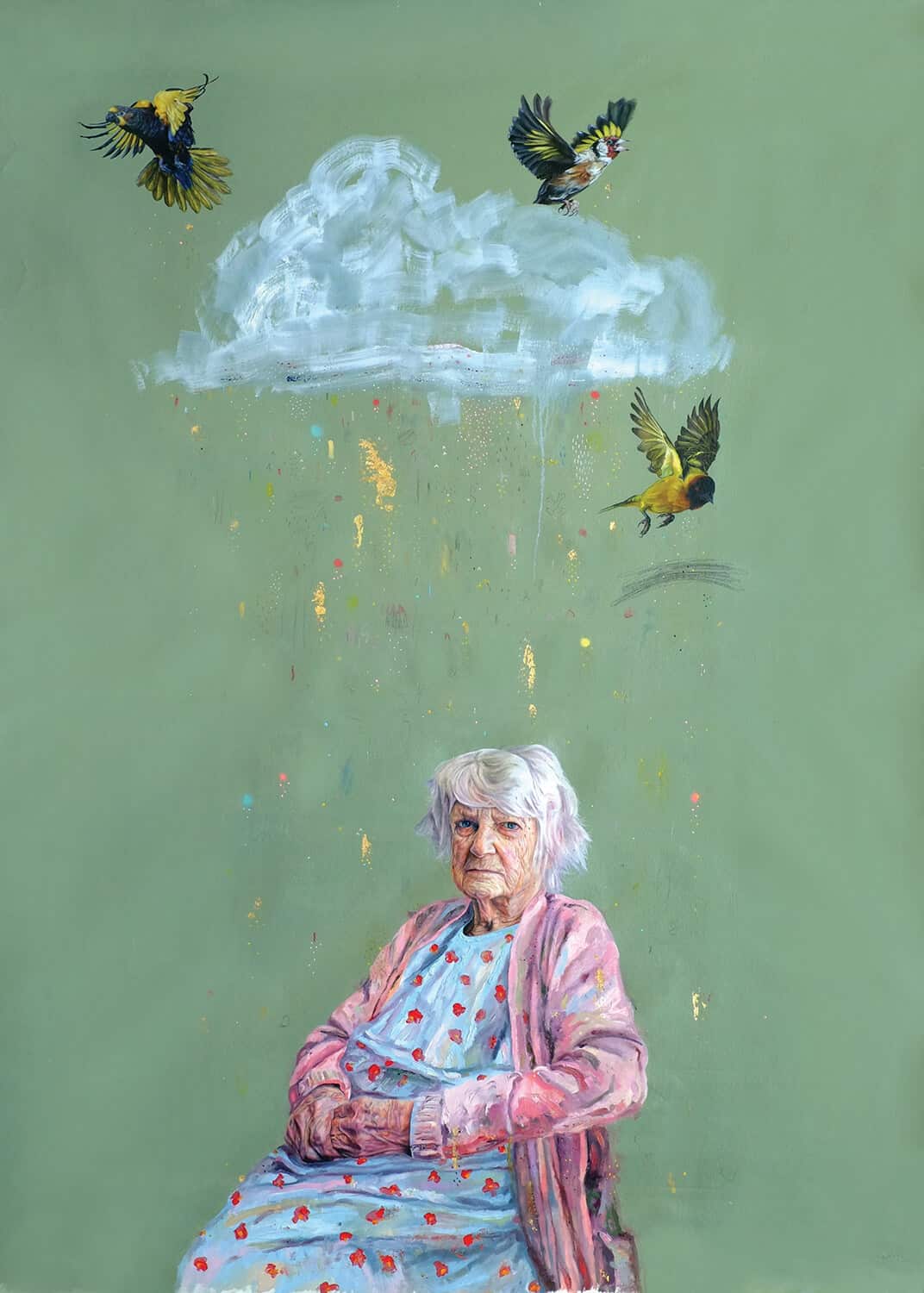
Jill’s patience, 2018. Oil on canvas, 141 x 198cm.
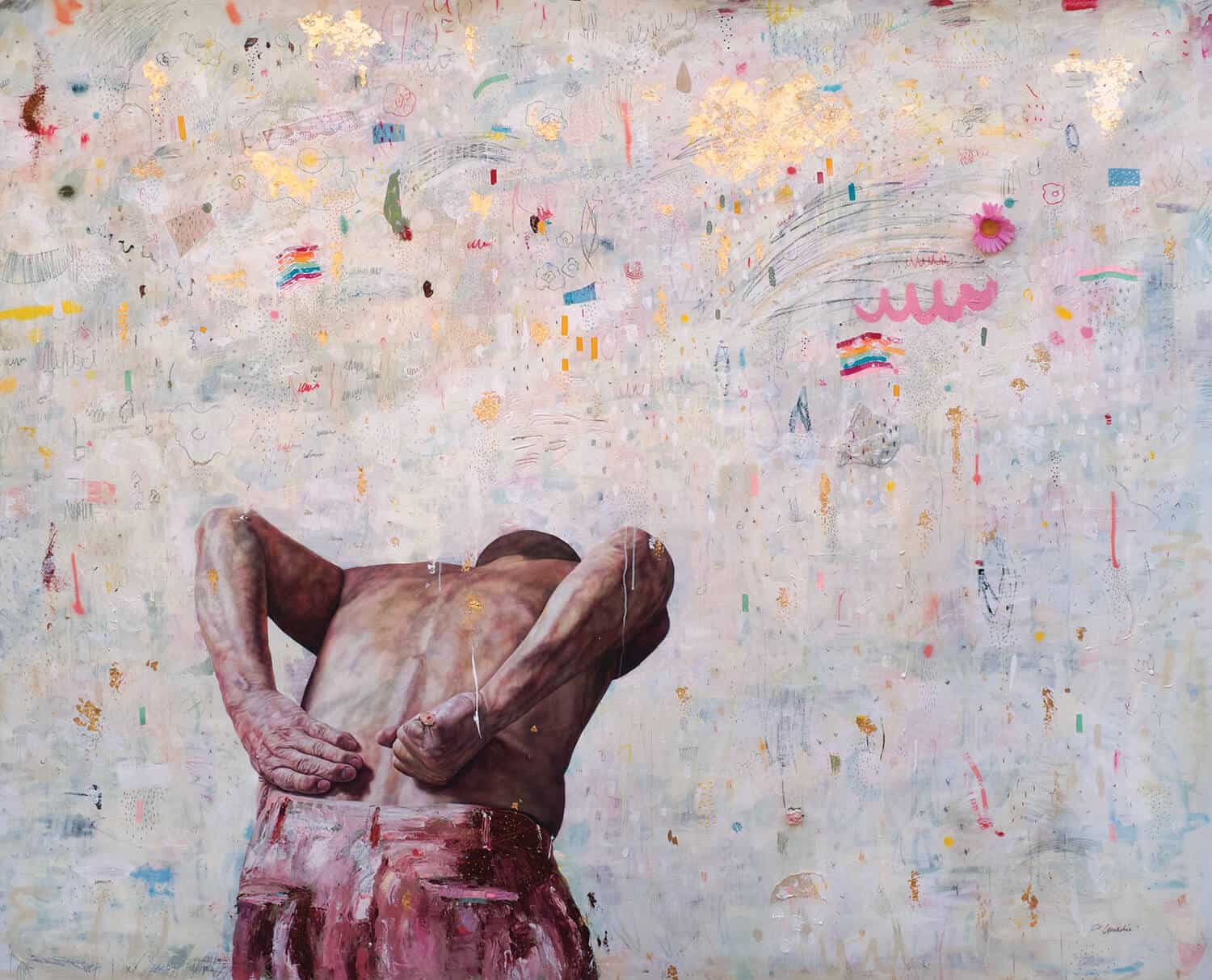
In the arms of sleep, 2018. Oil on canvas, 195 x 163cm.
A FEAST OF MANY COURSES
In her essay Labor, Work, Action (1964), Hannah Arendt extends De Beauvoir’s observation about rest/pleasure to the concept of labour, noting that ‘effort and gratification follow each other as closely as producing and consuming, so that happiness is a concomitant of the process itself.’ She draws an important distinction between labour and work, defining the former as a bodily activity which administers ‘to the needs of life.’ Thus, one labours to put food on the table or to give birth. In this sense, labour follows ‘the circular movement of our bodily functions.’ It does not come ‘to an end as long as life lasts’ but is ‘endlessly repetitive,’ and since labour ‘corresponds to the condition of life itself, it partakes not only in life’s toil and trouble but also in the sheer bliss with which we can experience our being alive.’
Unlike the perishable products of labour, work produces ‘use-objects,’ durable things which provide some sanctum of stability to the world. In the Marxist sense, the objects produced through work – tools, new technologies – relieve us from the burden of labour, yet as described by Arendt, ‘There is no lasting happiness and contentment for human beings outside the prescribed cycle of painful exhaustion and pleasurable regeneration,’ noting that ‘whatever throws this cycle out of balance’ – be it misery or the boredom of ‘an entirely effortless life’ – ultimately derails the possibility of fulfilment.
It is perhaps for this reason that those who retire soon find themselves fidgety, in need of a hobby, yet it would be remiss to discount the pleasure that rest affords. A life of endless toil would be equally (if not more) futile. Rather, it is the drive toward one mode of being at the expense of the other that is questionable, because regardless of how one arranges the hierarchies between work and labour (capitalism versus marxism etc.), the end-goal is still that of a quiet, contemplative, and uncomplicated life, one that is indifferent to and no longer dependent on life’s cycles.
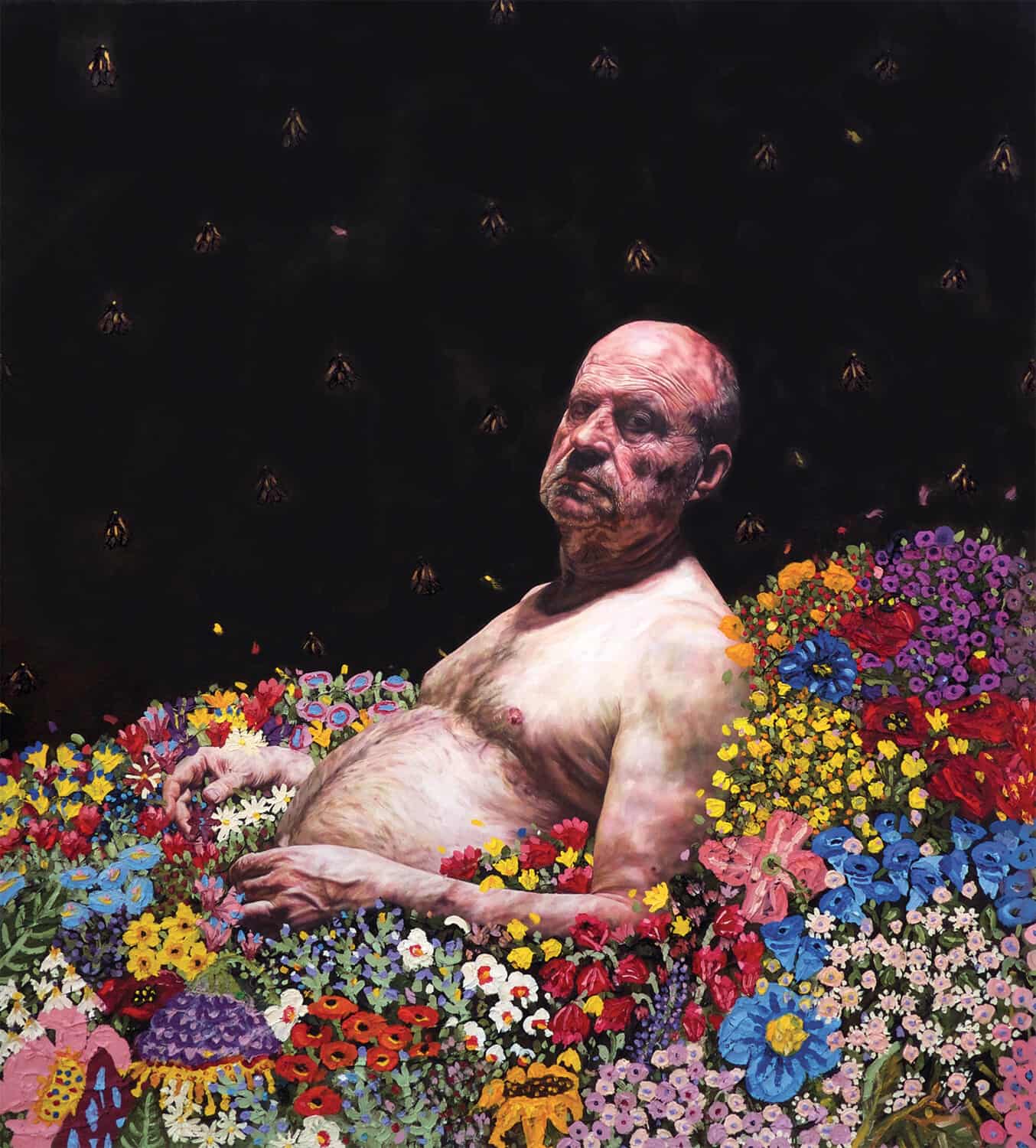
From either side of the isle, 2021. Oil on canvas, 118 x 130cm.
The relationship that Arendt has observed between pleasure and the biological processes of birth, consumption, and decay is, in a sense, metabolic. It ‘does not leave anything behind itself’ because whatever is produced through labour is immediately consumed. In contrast, ‘the work of our hands… fabricates the sheer unending variety of things whose sum total constitutes the human artifice, the world we live in.’ While Arendt’s perspective may parallel that of De Beauvoir, what interests me here is how her argument might relate to the interplay of natural and artificial elements in Conradie’s paintings. How, for example, the metabolic is made apparent, both in the bodies of his figures and their biological clockwork – a belly grown plump with age – and through the inclusion of other elements that either embody or disrupt this notion of the cyclical, such as his repeated depiction of flowers. In one of his more recent paintings, From either side of the isle (2021) – currently on show at 131 A Gallery, Cape Town – an elderly man sinks back into a bed of blossoming flowers, his chest and belly aglow against a black backdrop. Carravagio springs to mind, yet despite the sharp contrast, the climax is far subtler, incremental – a nod to the cyclical processes of regeneration and decay.
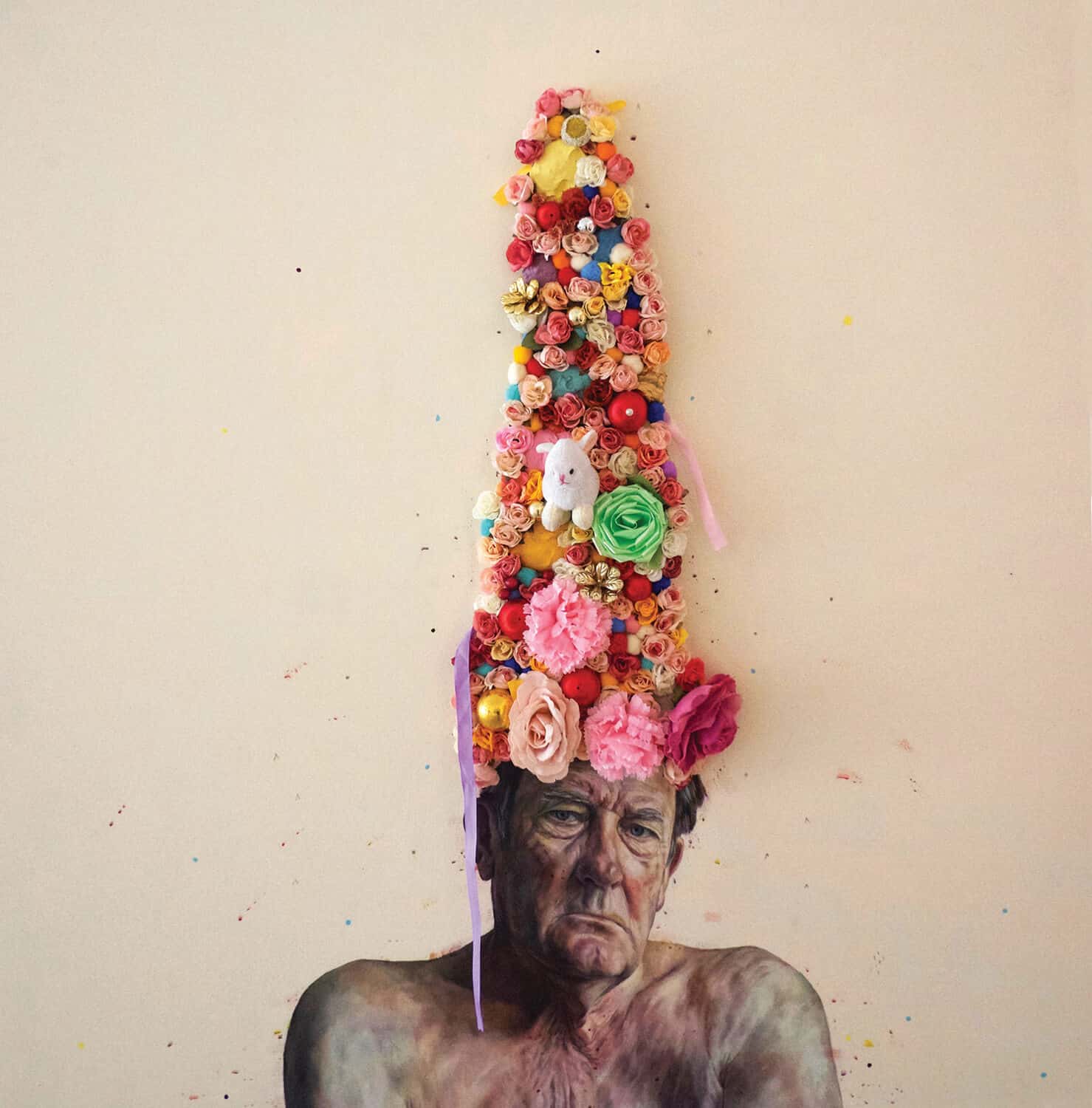
We skip by the oceans, we skip by the seas, 2017. Mixed media on canvas, 90 x 98cm.
In We skip by the oceans, we skip by the seas (2017) – originally shown at Galerie 55 Bellechasse, Paris – a sulky, somewhat comical-looking figure dons a crown of bright plastic flowers and fluffy toys, akin perhaps to a dunce cap or an upturned ice-cream cone. Here, however, the flowers and toys are stitched onto the canvas. They are supplementary to the figure, in the sense that they don’t occupy the same field but sit awkwardly atop his head. These are mass-manufactured objects; objects that are meant to withstand the passage of time. That they’re an odd fit somehow aligns with Arendt’s observation that it is the durability of the fabricated world which lends such objects their ‘relative independence’ from humanity, an objectivity through which people, ‘their ever-changing nature notwithstanding, can retrieve their identity by being related to the enduring sameness of objects, the same chair today and tomorrow, the same house, at least formerly, from birth to death.’
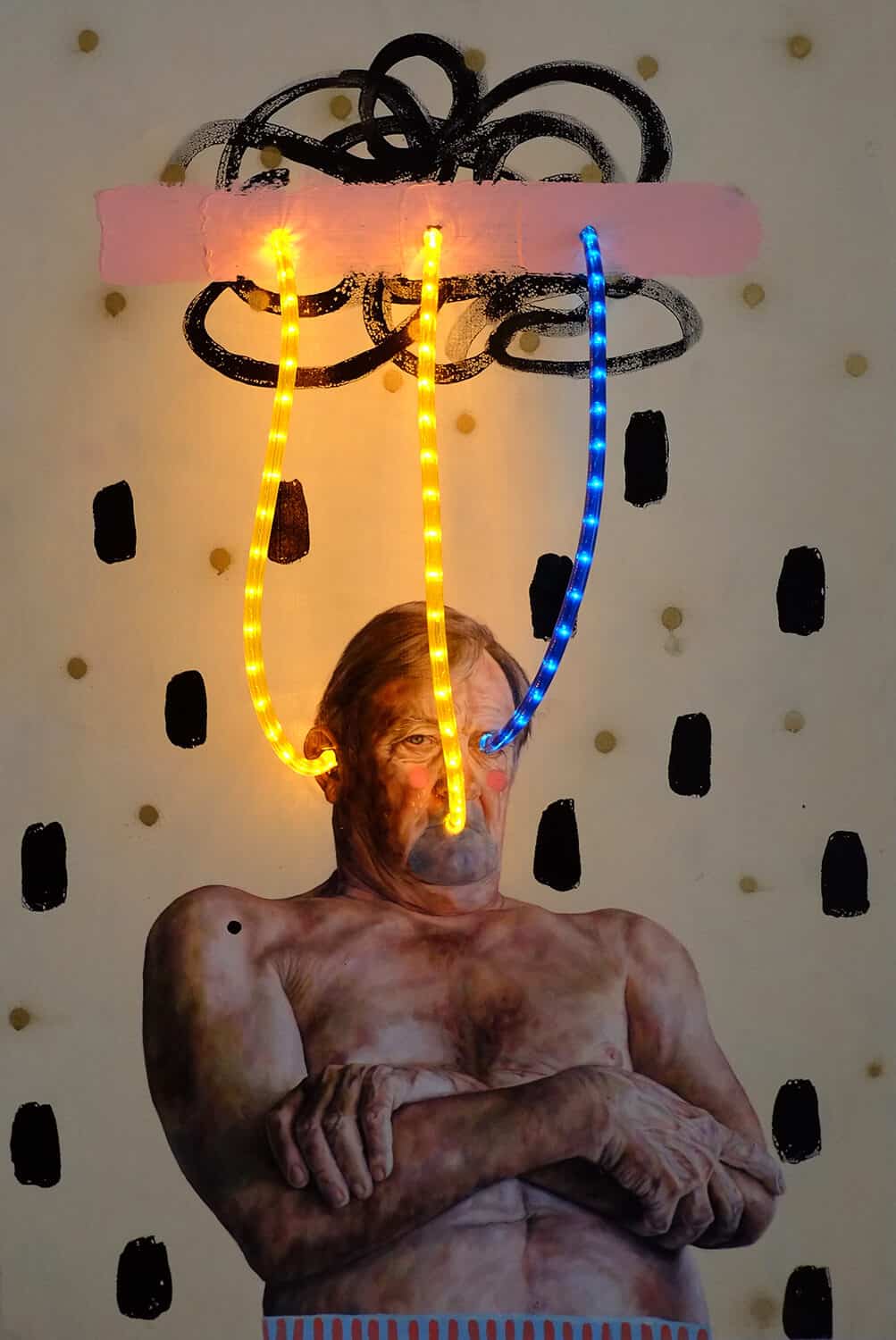
The vintage you wore to the feast, 2016. Oil on canvas, 67 x 87cm.
Thus, a person who holds onto their favourite childhood toy might look at it in awe of the wonder it once elicited, might long for the child they once were. This is quite a different experience to one’s relationship with the natural world, itself in a perpetual state of flux, yet the artificial objects included in Conradie’s paintings are anything but stable. Too much of a good thing, perhaps? As notes De Beauvoir, ‘The sweetest melody, repeated indefinitely, becomes an annoying refrain. The taste at first delicious soon sickens me.’ This is certainly true of The vintage you wore to the feast (2016), in which a saturated figure is force-fed bright neon through tubes, one for the mouth, ear, and eye. It is the kind of image that I associate with excess: with doom scrolling, convenience shopping, work fatigue, and indigestion, with quick-fixes, 24-hour casinos, and bottomless slot machines – the dark flip-side of that perennial pot of gold. For while endlessly repetitive, it is not Arendt’s laborious cycle of effort and gratification – ‘of painful exhaustion and pleasurable regeneration’ – that I feel from this work, but the monotony of ‘an entirely effortless life.’
The forty-three-plus fairs and exhibitions in which Conradie has been involved since 2015 – from London, Paris, Barcelona, Istanbul, and Brussels to New York, San Francisco, Miami, Basel, and Brussels – are testament to the fact that he is no stranger to hard work. This is no small feat, especially when one considers that he’s spent the better half of the past two decades bouncing from one metropole to the next. As described by De Beauvoir, ‘An unchanging enjoyment that stays the same for too long is no longer felt as a plenitude; in the end it merges with a perfect absence.’ This might explain Conradie’s penchant for travel, but I also believe that his prolific output points toward the temperament of someone who is never quite satisfied with the finished ‘product’; someone for whom enjoyment is found in the act:
For enjoyment is the presence of an object to which I feel present. It is presence of the object and of myself in the heart of their difference. But as soon as the object is handed over to me, the difference dissolves. There is no longer an object, but once again a single, empty existence that is but vapidity and ennui. As soon as I eliminate the distance that, in separating me from the object, allows me to throw myself toward it, to be movement and transcendence, this fixed union of the object and me no longer exists except in the way a thing does.
It is this desire – to be present within the heart of difference, ‘to be movement and transcendence’ – that I believe underscores much of Conradie’s work. Consequently, when I talk about the tension inherent in his paintings – the friction generated between elements or the strange economy of sustenance, sufferance, and satisfaction that I find so present – I am not talking about a kind of ‘dramatic tension’ which ‘transforms everything… merely into steps leading to the final resolution,’ but rather, after Kundera, ‘a feast of many courses.’ And I don’t just contemplate it. ‘To enjoy a good thing is to use it, to throw oneself with it toward the future.’
Christiaan Conradie’s solo exhibition, ‘Against a narrow heart’, will be on show at 131 A Gallery, Cape Town, from the 29th of April 2021.
Sven Christian is an independent writer, editor, and curator.



